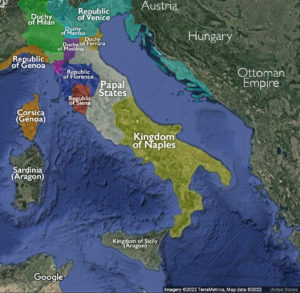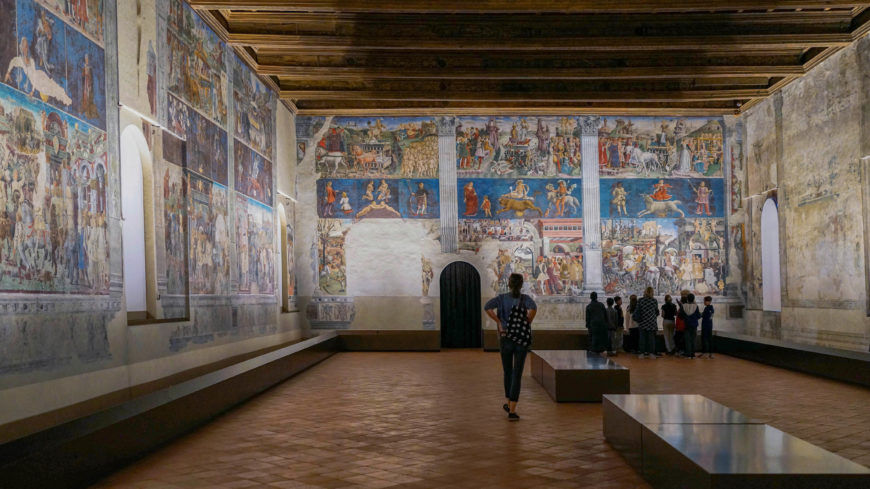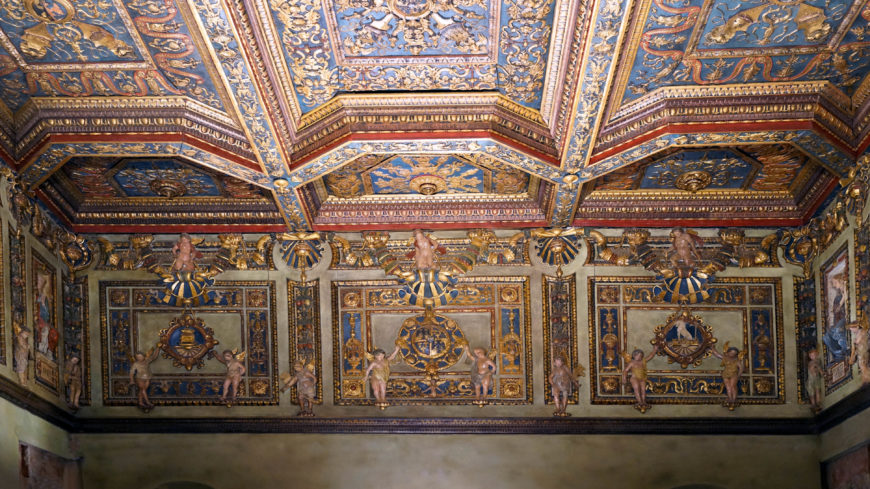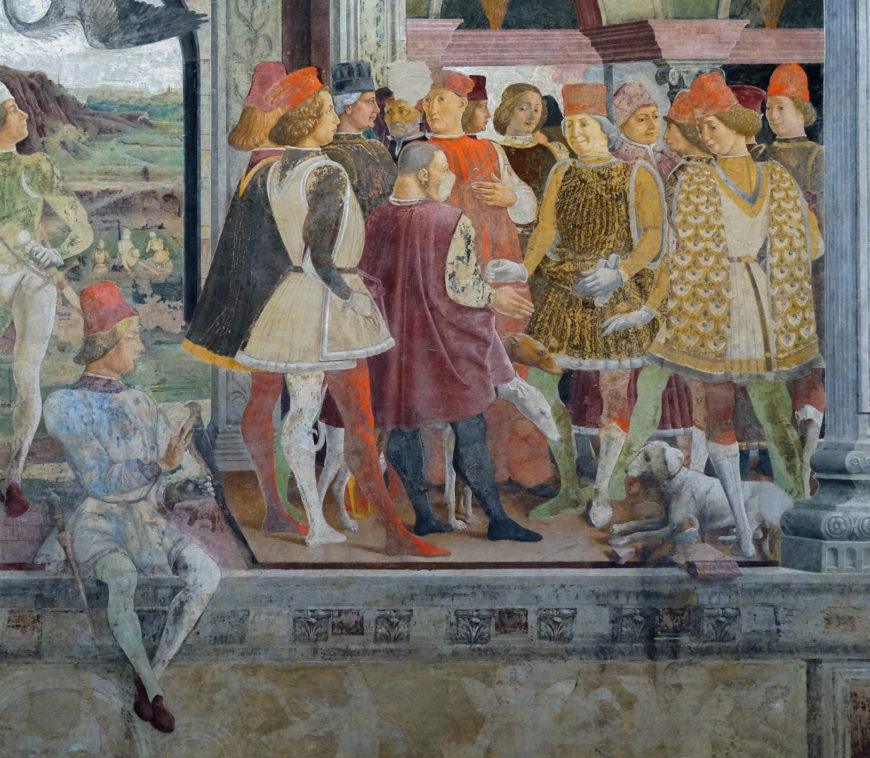
Image of Borso d’Este with this court, April panel, in the Sala dei Mesi, 1460s, Palazzo Schifanoia, Ferrara (photo: Lauren Kilroy-Ewbank, CC BY-NC-SA 2.0)
He dazzles. He shimmers. He shines. Bedecked in flashy gold brocade and a jaunty red cap, Borso d’Este, ruler of the Italian city-state of Ferrara, smiles as he greets a supplicant whose simple garb stands in sharp contrast to that of his glittering lord. This interaction is one of many recorded upon the walls of the massive audience hall (12 x 24.4 m) known as the Sala dei Mesi (Room of the Months) in the once spectacular pleasure palace, the Palazzo Schifanoia. In this brilliant—if damaged—series of paintings created in the 1460s, Borso appears repeatedly. Magnanimous and splendorous, the finely dressed ruler oversees the activities of his court.
Though little survives of the d’Este family’s enormous cultural investments, like other renaissance ruling families, they used the patronage of art and architecture to their advantage. The frescoes at Schifanoia communicate Borso’s able leadership, his benevolence, and his noble virtue.
The Italian renaissance prince, Borso d’Este
“Uneasy lies the head that wears the crown,” or so says William Shakespeare’s King Henry IV in his play of the same name. The line’s meaning is clear: being a leader is difficult and responsibility can be burdensome. That said, in the words of Mel Brook’s King Louis XVI (another historical monarch conjured for the stage), “It’s good to be the king” (History of the World, Part I, 1982). Ruling is hard, but it has its perks.
For the Italian renaissance prince, these perks included the financial and social resources to patronize spectacular works of art and architecture in celebration of one’s personal magnificence. Borso d’Este is a case in point.
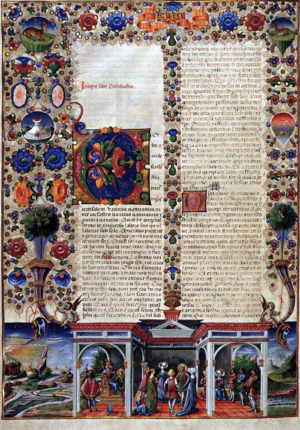
Taddeo Crivelli, page from the Bible of Borso d’Este, 1455–61, illumination on parchment (Biblioteca Estense Universitaria)
Borso was an experienced soldier and politician, and he was also engaging and popular. During his reign he traveled extensively throughout Ferrarese territory, making a grand impression wherever he went with his large entourage and taste for fine clothing and costly jewels. The elaborate cycle of paintings that he commissioned for his family’s pleasure palace provides insight into his extravagant tastes. Borso’s lavish patronage was intended to encourage favorable comparisons with the grandeur of ancient Rome and the courtly splendor of the medieval chivalric traditions favored by the French Burgundian dukes, the richest and most glamorous in all of Europe—and the gold-standard in magnificence at the time. Such dazzling displays were calculated political tactics. Showcasing the wealth accumulated due to Borso’s able leadership communicated his right to rule while demonstrations of his good taste—his ability to put this great wealth to appropriate use—reinforced his inherent nobility.
Borso’s savvy diplomacy and splendid self-presentation encouraged the Holy Roman Emperor Frederick III to raise the imperial fiefs of Modena and Reggio—part of the d’Este’s territorial holdings—to the status of dukedom in 1452. Pope Paul II was similarly persuaded by Borso’s extravagant displays and promises of political support, and invested him as Duke of Ferrara in 1471.
The Palazzo Schifanoia and the Sala dei Mesi
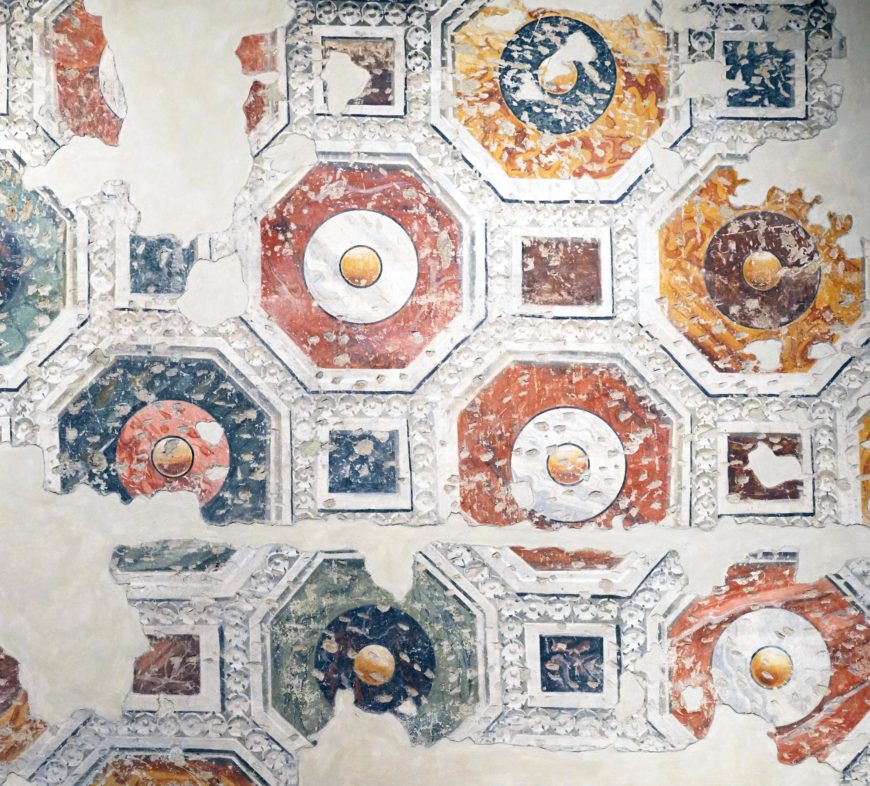
Fresco decoration once on the exterior façade, Palazzo Schifanoia, Ferrara (photo: Lauren Kilroy-Ewbank, CC BY-NC-SA 2.0)
Like their ruling-class peers, Borso’s family (the d’Este) had residences both in the urban center and in the countryside. While the family’s official residence and administrative hub in the city was the Palazzo del Corte, the ruling Este lords spent much of their time in the family’s numerous pleasure palaces. As sites for recreation and escape from official duties, these delightful suburban residences were aptly named: Belriguardo (“beautiful outlook”), Belvedere (“beautiful view”), Belfiore (“beautiful flower”), and Palazzo Schifanoia (a play on schivare la noia “escape from boredom”).
During his rule Borso invested heavily in renovating and adorning his family’s residences. This included the expansion and refurbishment of Palazzo Schifanoia, their fourteenth-century summer palace in the city’s southeastern quarter (at the time, seen as a suburb). Unlike more public works in the city’s religious and civic sites, the architecture and decorations of a private palace or villa were seen by a limited audience. The images encountered here were intended to impress visiting dignitaries and to bring pleasure to the ruler and his courtiers.
While Schifanoia originally boasted elaborately carved ceilings, gilt and polychrome stucco work, and extensive frescos throughout, the best-preserved works today are the wall paintings in the room known as the Sala dei Mesi (Room of the Months). This large hall would have served as a reception room for semi-public events and a delightful setting for court entertainments. Decoration of the space was a collaborative effort involving the contributions of visual artists from throughout Northern Italy.
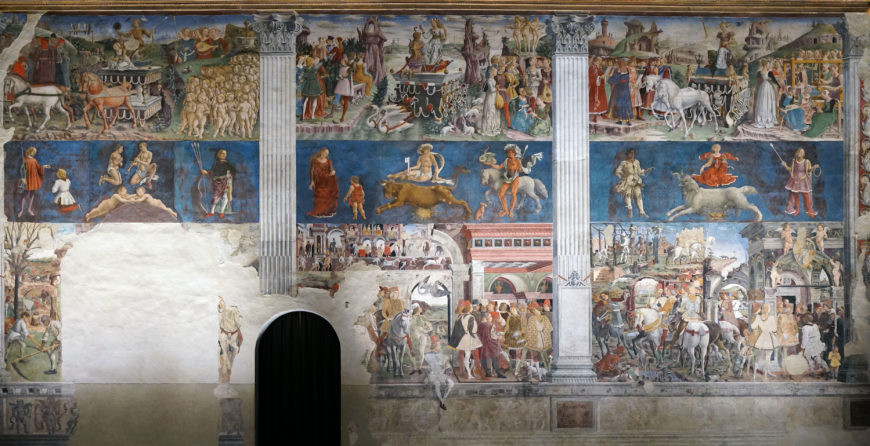
March, April, and May, in Sala dei Mesi, 1460s, Palazzo Schifanoia, Ferrara (photo: Lauren Kilroy-Ewbank, CC BY-NC-SA 2.0)
The works demonstrate an interest in aristocratic leisure, classical mythology, and naturalistic visual effects. Organized with astrological signs for each month above with scenes of seasonal activities below, like the calendar pages of a Book of Hours—a courtly art form prized by Italian rulers—the decorative program of the Sala dei Mesi was intended to celebrate the government of Borso d’Este within a seasonal framework that showed his court in harmony with the universe.
The allegories of the months
The four walls of the hall are divided into nineteen panels, twelve of which are devoted to the months of the year. The seven scenes outside the calendar cycle are heavily damaged but include depictions of tournaments, architecture, and courtiers on horseback.
Of the surviving allegories of the months depicted in the Sala dei Mesi, those by Francesco del Cossa—March, April, and May—are among the best preserved. His depiction of the month of April, for example, is rich with minute detail, much like that prized in the precious illuminated manuscripts that Borso and his peers collected, such as Borso’s Bible shown earlier.
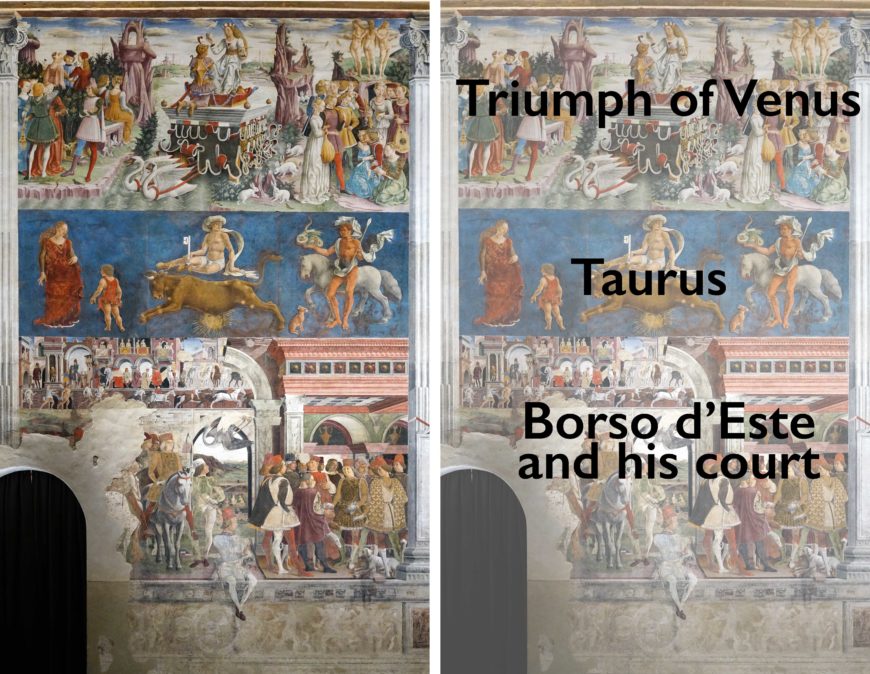
April panel, in the Sala dei Mesi, 1460s, Palazzo Schifanoia, Ferrara (photo: Lauren Kilroy-Ewbank, CC BY-NC-SA 2.0)
Like all the month’s shown in the frescoes, the month of April is divided horizontally into three registers. The uppermost register depicts a triumphal celebration of the Olympian deity who in ancient tradition reigned over that particular month (Venus lords over April, for example); the middle registers contain the appropriate monthly zodiac signs (below April’s Venus is Taurus) and three decans, figures who represent equal segments of the month; the lowest registers include scenes depicting the seasonal activities of Borso d’Este and his entourage. April finds them engaged in lively chatter and heading out to hunt.
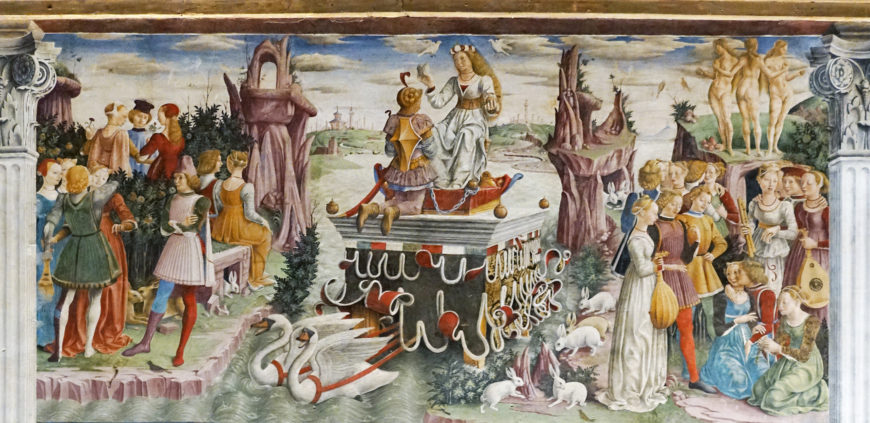
Triumph of Venus, top of the April panel, in the Sala dei Mesi, 1460s, Palazzo Schifanoia, Ferrara (photo: Lauren Kilroy-Ewbank, CC BY-NC-SA 2.0)
Let’s look more closely at the three different registers that make up the month of April.
In the upper register, the Roman goddess Venus rides in triumph upon a fantastical watercraft drawn by two swans through a lush, sweeping landscape. Mars, the god of war, kneels before her. Venus is surrounded by signs of fertility and abundance including frolicking rabbits and richly attired couples courting, some locked in amorous embraces. The Three Graces—ancient symbols of female fecundity and beauty—stand in graceful nudity in the upper right corner.

Taurus, middle of the April panel, in the Sala dei Mesi, 1460s, Palazzo Schifanoia, Ferrara (photo: Lauren Kilroy-Ewbank, CC BY-NC-SA 2.0)
While the uppermost register transports us to a mythical paradise of sweeping landscape, lush foliage, and beautiful courtiers, the celestial realm is conjured in the middle register by the Zodiac taurus set against a deep blue sky.
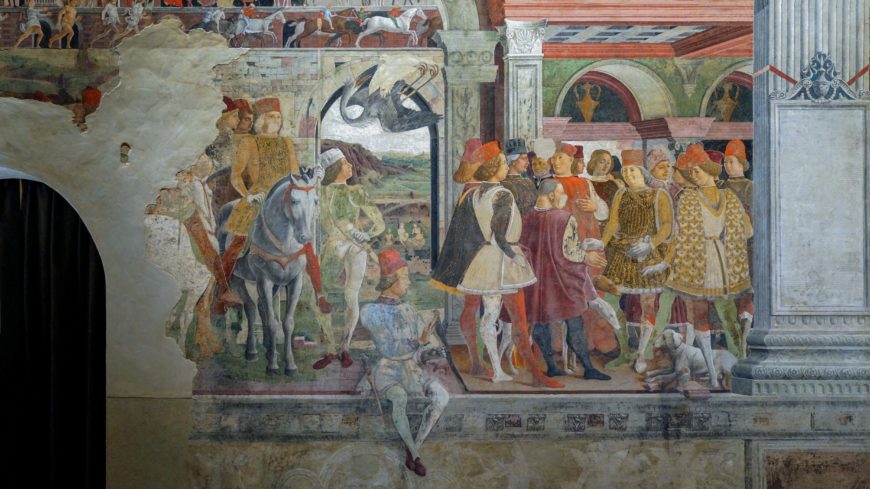
Image of Borso d’Este with this court, April panel, in the Sala dei Mesi, 1460s, Palazzo Schifanoia, Ferrara (photo: Lauren Kilroy-Ewbank, CC BY-NC-SA 2.0)
At the lowest level we encounter the earthly realm, where Borso himself stands at the right of the scene below a classical portico. The only figure whose body is unobstructed from the viewer, the ruler is splendidly dressed, with hunting dogs at his feet, and smiling upon the adoring courtiers who gather around him. A distant horse race is visible in the upper left corner of the register while just below and to the left of Borso, courtiers on horseback enter into the space. Here, and in every lower zone of the months, Borso presides over a joyous world in which satisfied peasants labor cheerfully and nobles engage in the aristocratic pastimes of hunting and riding secure in the benevolence and justice of their lord. The courtier who sits with legs dangling over the edge of the fictive ledge at the bottom of the April scene breaks into the viewer’s space, inviting them to see the idealized realities painted there as an extension of their own world.
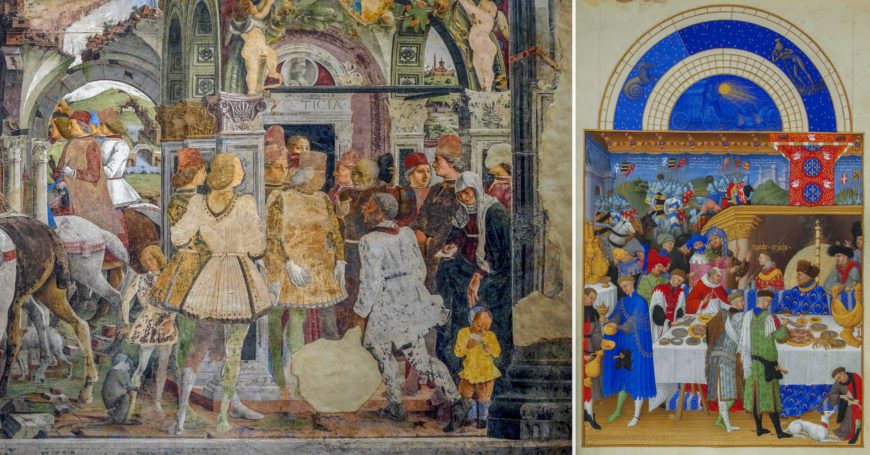
Left: Image of Borso d’Este with this court, March panel, in the Sala dei Mesi, 14560s, Palazzo Schifanoia, Ferrara (photo: Lauren Kilroy-Ewbank, CC BY-NC-SA 2.0); right: Limbourg Brothers, January, from Les Très Riches Heures du Duc de Berry, 1413–16, ink on vellum (Musée Condé, Chantilly)
A sign of sophistication and virtue
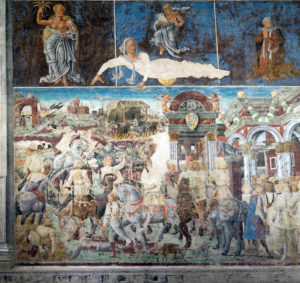
The astrological sign Virgo and Borso d’Este with this court, August panel, in the Sala dei Mesi, 1460s, Palazzo Schifanoia, Ferrara (photo: Lauren Kilroy-Ewbank, CC BY-NC-SA 2.0)
The room’s iconographic program was undoubtedly devised by a humanist advisor, although scholars have yet to agree on just who this may have been. While the artists who painted here had the visual training to create these scenes, the complexity of the subject matter would have required the insights of someone well-educated in classical history and literature as well as an awareness of visual precedents like the Duc de Berry’s Tres Riches Heures. The selection of imagery at Schifanoia, with its references to astrology (seen in the signs of the Zodiac), classical antiquity (seen in Roman deities), and the courtly traditions of the Burgundian duchies which were intended to reflect Borso’s sophistication and virtue.
The surviving decorations of Schifanoia offer modern viewers a precious glimpse of the splendorous forms that once adorned the d’Este’s numerous palaces and villas, most of which have been destroyed in the intervening centuries. Ironically, these frescoed scenes are among the least of Borso’s investments in visual art, signaling his preference for the more precious (costly!) arts of tapestry, manuscript illumination, and architecture. Indeed, he famously paid for the frescos by the square foot at a cost of 800 ducats (gold coins)—a trifling expense compared to the 9,000 he spent on a set of tapestries.

